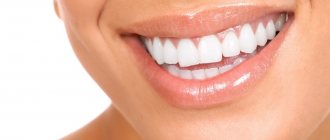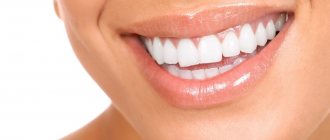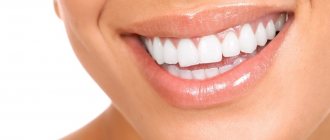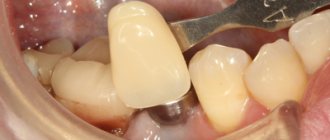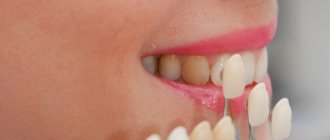If you want to improve the appearance of your smile, if you don’t like something about it, but you cannot accurately and correctly formulate what exactly, if you want to talk with your dentist about the aesthetics of your smile in the same language, then the following note is just right for you.
Nature (or God... depending on your views on life) has made us different. And our originality and uniqueness have its own charm. But what to do when this uniqueness goes too far beyond our ideas of beauty? How to formulate your claims to nature (and perhaps to the previous intervention of dentists)? To assess the aesthetic component of our face, lips, teeth - everything that gives rise to a beautiful, harmonious smile, it turns out that there are many parameters. This is what dentists use (at least should use) when planning changes in your appearance. Since there are very, very many different nuances, and I do not have the task of making each of you an expert in the field of aesthetic dentistry , we will focus on the ten simplest and most important.
Parallelism of horizontal landmarks.
One of the most important signs of a harmonious smile is the parallelism of imaginary lines: the interpupillary line (in the picture there is a blue line connecting the right and left pupil of the eye) and the lip line (in the picture there is a red line drawn between the corners of the mouth).
Both of these lines should also be parallel to the lines connecting the edges of the central incisors (green) and the incisal cusps of the canines (blue)
Gum level.
A smile looks attractive and more aesthetically pleasing , in which the line connecting the necks of the teeth (shown in dotted lines) repeats the line of the upper lip, and the level of gum exposed when smiling is symmetrical on the right and left. At the same time, with a maximally open smile, only the gum “triangles” between the teeth and a small strip of gum above them (no more than 2-3 mm wide) should be noticeable.
Thus, the gums around the upper teeth, upper and lower lips form a kind of frame for your smile. If the “picture” is not visible behind the frame, then such a smile will not look attractive.
Excessive visualization of the gums (the so-called “gummy smile”) is most often eliminated with the help of surgery, orthodontic treatment, as well as cosmetic interventions (for example, Botox injections into the upper lip, upper lip augmentation, etc.).
The smile looks symmetrical
The basis of a beautiful smile is symmetry, that is, one half of the lips should be symmetrical to the other. When smiling, about 40 different facial muscles work, but they are all trained differently, which is why the smile often turns out to be asymmetrical.
Facial muscles can be trained with simple exercises (these exercises will not only make your smile perfect, but will also help avoid the appearance of facial wrinkles and improve diction).
- Purse your lips, pull them into a tube and hold them in this position for a few seconds. Then relax your lips. Repeat 5-8 times.
- Close your lips tightly, stretch them forward and try to make a figure eight with them. Then relax your muscles. Repeat the exercise 2-3 times.
- Stick out your tongue, clasp it tightly with your lips and hold this position for a few seconds, then relax the muscles of your lips and tongue as much as possible. Repeat five times.
- Stretch your lips into an unnaturally wide smile, and then relax them. Repeat five times.
Vertical symmetry and midline.
A line passing through the center of the face should pass exactly between the central incisors of the upper jaw. The discrepancy between these lines causes a feeling of disharmony even with a quick glance at your smile from the outside. In this case, it is not at all necessary that it also passes between the central lower incisors. Firstly, a complete match is rarely found, and secondly, this in no way affects the aesthetic perception of your smile when viewed from the outside.
How to learn to smile correctly
Practice
Chances are that your natural smile is something that other people are more familiar with than you are. Although the selfie trend has made us more conscious of how we look, our smile is one of the natural features that is difficult to recreate in artificial settings.
If you really want to hone your technique, be sure to practice your smile regularly. Although you may feel a little silly smiling at yourself in the mirror, it will help you identify the best parts of your smile and use them.
When you take the time to evaluate your smile, you may find that you can make small changes to make it even more expressive. For example, if you wet your teeth before smiling, they will look shinier and brighter. Trying out your “best smile” is a great way to make sure you have good technique and are camera-ready.
Find the right lip shade
Lipstick and gloss have a big impact on your smile. Bold color is eye-catching, so be prepared for your smile to be your defining feature if you wear a bold shade. No matter what shade you choose, remember that it will affect the appearance of your teeth.
Depending on your natural skin color, warm or cool tones may suit you better. When you wear products with the right foundation, your natural features will be enhanced. An almost imperceptible difference in the shade of your lip gloss can suddenly make your skin glow and your teeth whiter. If you want to minimize the appearance of tooth stains, try using blue and pink undertones in your lip color, but avoid dark shades.
If your favorite lip gloss doesn't match your natural color, don't despair! You can apply a brightening gloss over any lipstick to change the shade and complement your skin tone.
Work on your facial muscles
It is commonly said that it takes fewer muscles to smile than to frown, but in reality the difference may not be as big as you think. We know that smiling involves a huge number of muscles.
Knowing your muscles and how your smile affects them can help you achieve your perfect smile. In addition to the lips and mouth, evaluate the muscles surrounding the jaw, chin, neck, and even the eyes. A natural smile will affect all of these areas and change your appearance.
For best results, try to smile without visible muscle involvement. For example, try to leave a small gap between your upper and lower teeth when you smile. This will prevent the neck muscles from protruding and create a better overall aesthetic effect.
Go to the dentist
Of course, the best way to maintain a beautiful smile is to take care of your teeth and gums. Regular visits to the dentist will help you keep your teeth healthy and smile proudly whenever possible. Not to mention, a healthy dose of general and advanced cosmetic dentistry can do wonders for your smile confidence, which will only make your smile that much more beautiful!
If you're not entirely happy with your smile, your dentist can also make recommendations and offer treatment options. To close small gaps or remove heavy staining, dental veneers may be the best option. Additionally, misaligned teeth can be straightened with orthodontic treatment, such as permanent braces or retainers. If dental problems or injury have left gaps in your smile, missing teeth can be replaced with implants, bridges or crowns.
Tighten your lips
While cosmetic treatments are one way to achieve fuller lips, there are several effective makeup tricks you can use at home to achieve a similar effect. For example, applying lip gloss or lipstick slightly outside your natural lip line will instantly make your lips look fuller. In addition, using lip liner to artificially enlarge your lips has the same effect.
Highlighting the area immediately surrounding your lips is also a surefire way to make your smile look fuller. To do this, use a special highlighter or simply take the nearest tube of concealer to make your lips more expressive.
Focus on the eyes
When you want to achieve a beautiful smile, your thoughts immediately turn to your teeth, gums and lips. However, the appearance of your eyes also has a big impact on how your smile looks. A sincere smile reaches and reflects into the corners of your eyes, so it should come as no surprise that your eye makeup can also affect your smile.
Many makeup artists recommend using cooler eye tones when you want to make your smile your best feature. Green, purple and blue tones in the eyes reflect the yellowness that can occur due to stained teeth. This handy trick is a great way to minimize the effects of light staining caused by drinking too much coffee or fruit juice, so it can be used by most people.
"Golden proportion".
The principle of the golden proportion in relation to a smile in aesthetic dentistry is that when looking at it from the front strictly in the center, the ratio of the apparent width of the front teeth should be approximately the following - 0.6 (width of the canine): 1 (width of the lateral incisor): 1.6 (width of the central incisor ).
As can be seen in the photo, the width of the visible part of the remaining teeth (4s, 5s) should consistently decrease, creating a sense of perspective.
A smile with downturned lips: what does it mean?
By the nature of the smile and the position of the lips, one can determine what a person is thinking about. Experienced psychologists always understand what this or that lip gesture means. Therefore, if a person smiles with all 32 teeth, he does it sincerely, he likes everything that happens.
A smile with downturned lips, what does it mean:
- However, a smile in which the corners of the lips are drawn down means that the person is doing it tensely; perhaps he does not like what is happening, he feels some tension. By the nature of the position of the lips, you can determine what a person is thinking about.
- A free smile speaks of naivety and good mood. If the smile is strained, this indicates hypocrisy. A smile of embarrassment is a kind of commissioned gesture. This lip position is fictitious, and often indicates how a person is feeling.
- If, while smiling, the lips remain closed and pressed tightly against each other, this indicates detachment from everything that is happening. In addition, such a smile speaks of dominance. A crooked smile indicates that the person is pretending to be friendly.
- In fact, he has a bad attitude towards the interlocutor, and may feel hatred or wariness towards you. For example, such a smile often occurs if the manager tells a joke that is not funny, but the employees are supposed to laugh.
Corners omitted
A lot of interesting information about the face can be found in the articles:
Physiognomy of a man and a woman by the shape and location of wrinkles, moles on the face, facial expressions
How to read a person’s character by facial features - physiognomy
Please note that you can tell about a person’s character and mood not only by a smile, but also by the position of the eyebrows, nose and direction of the eyes.
Proportions of the tooth.
The central incisors of the upper jaw always attract special attention, because... best visible when talking and smiling. Therefore, it is very important that their proportions are correct. The most harmonious looking teeth are those with a ratio of tooth width to length of approximately 0.7-0.8: 1
However, at different ages this ratio may change. Due to the physiological wear of teeth in older age, this ratio tends to be 1:1. Therefore, if you want to “rejuvenate” your smile, you usually need to increase the length of the tooth.
Physiognomy - narrow, thin lips in women and men: character
It is also necessary to pay attention to the hollow between the lips. If it is present in the area of the upper lip, pointed, then these are creative individuals with a sharp mind. They achieve success, always strive for their dreams, achieve great success, both in work and on the personal front. If a person has a rounded cleavage, then this indicates a romantic character.
Physiognomy - narrow, thin lips in women and men, character:
- Thin lips speak of secrecy, modesty, and restraint of the owner. Usually such people are stingy, not only in terms of financial spending, but also in the area of emotions. They are always reserved and rarely express their opinions. But that doesn't mean they don't have it.
- They are always somewhat self-confident and do not say what they are going to do. Such people are usually not very liked, since they calculate everything in advance, and, if necessary, can go over their heads when it comes to the career ladder.
- They often get upset over little things, any negativity immediately becomes the cause of frustration and worsening mood. If a person has practically no hollow, that is, there is a solid line in the center of the lip, then the nature often remains at work and loves to work.
- Despite the large amount of work, he will always find a solution. These are excellent workers who unquestioningly follow all instructions from management, and do it brilliantly. Achieve great success in work and in financial matters and are absolutely independent.
Thin lips
Interincisal angles.
Interincisal angles are the spaces between the cutting edges of the anterior group of teeth.
With the harmonious construction of teeth, these angles should gradually increase from the center to the periphery: from a small closed angle between the central incisors, to a more direct and even open angle between the 2nd and 3rd teeth.
Tooth wear leads to a decrease or complete absence of interincisal angles, which makes the patient look older when he smiles.
At the same time, “female” teeth are characterized by rounded corners of the incisors, while “male” teeth are characterized by straighter ones.
Zenith of the gingival contour.
The zenith of the gum is its most concave part around the neck of the tooth (indicated by dots in the photo).
The level of zeniths near different teeth in the smile zone should be at different levels. For the central incisors and canines - approximately at the same level (or slightly higher for the canines), for the lateral incisors - slightly lower than both (as shown by the lines in the photo). At the same time, it is equally important that the zeniths on symmetrical teeth are at the same level. This is especially important to consider if this area becomes noticeable when smiling. When even with the most open smile the gums are not exposed, then there is no serious need to set the zeniths perfectly symmetrically.
In this case, attention is drawn to the too low zenith level on tooth 12; it is significantly lower than the symmetrical tooth 22. There is also a slight difference in the position of the zeniths on the central incisors (teeth 11 and 21). As a result of treatment, these shortcomings were eliminated, as can be seen in the first photo.
What kind of smiles are there?
Duchenne's smile
The first steps towards deciphering this multi-purpose expression were taken by the 19th century neurologist Duchesne de Boulogne. He was the son of a French pirate and had a penchant for electrocuting his patients—and became, among other things, the founder of electrotherapy. Duchenne was interested in the mechanics of facial expressions, including how the facial muscles contract to produce a smile. The best way to study this, he decided, was to attach electrodes to a person's face and make their muscles move.
This procedure was so painful that at first Duchesne could only experiment on the freshly severed heads of revolutionaries. Then one day, purely by chance, he met a middle-aged man with facial insensibility in a Paris hospital - that is, he found his guinea pig among people.
In total, Duchesne discovered 60 facial expressions, each involving its own group of facial muscles, and depicted them in a series of gruesome photographs. In the most famous of them, the face of the unfortunate man is distorted by a wide toothless smile. He looks like a happy idiot, with his cheeks lifted and crow's feet around his eyes.
This smile became known as the "Duchenne smile" and became associated with genuine feelings of joy and giddy happiness. This smile is long and tense, although it is associated with the contraction of only two muscles. First, the zygomaticus major muscle, which is located in the cheek, tightens the corners of the mouth, and then the orbicularis oculi muscle, which surrounds the eye, leads to the characteristic wink.
This smile is long and tense, although it is associated with the contraction of only two muscles.
But here's the rub. "In some places in the world, the perception of a genuine smile does not seem to depend on the presence of crow's feet near the eyes," says Niedenthal.
Which brings us to a question that has puzzled scientists for more than a century, from Darwin to Freud: Are our expressions instinctive and universal, or dependent on the culture into which we are born?
Smile of fright
One of the clues comes from our closest relatives. Although the Duchenne smile may seem most natural today, some scholars believe it may have originated from an expression with a completely different meaning. "When bonobo chimpanzees are afraid, they bare their teeth and pull their lips back to expose their gums," says Zanna Clay, a primatologist at the University of Birmingham.
The barely-toothed smile is often shown on greeting cards, but among chimpanzees it is a submissive gesture used by low-status individuals to appease dominant members of the group. Clay cites the example of a popular video of a chimpanzee stealing a rock. “She steals a rock and then shows a big, cheeky smile. She looks like she's laughing, but she's probably nervous," Clay says.
Although we don't tend to associate smiling with fear in people, there are some hints that smiling may be caused by fear. In babies, a wide smile can mean they are happy or worried, and studies have shown that men tend to smile more among those perceived to be of higher status.
Darwin believed that facial expressions were instinctive, originally developed to serve practical functions. For example, raised eyebrows increase the field of vision, which may have helped our ancestors detect predator ambushes in time. In chimpanzees, a fearful smile shows that the teeth come together tightly, as if to show that they are not going to bite anyone.
To prove his point, Darwin conducted an experiment at his home in Down, a quiet village near London. He took 11 photographs of Duchenne—they corresponded regularly—and asked 20 of his guests to guess what emotions they represented. They unanimously identified happiness, fear, sadness and surprise, among others, and Darwin concluded that these expressions were universal.
Sad smile
We now know that smiling is indeed instinctive, but not only when we are happy. A "sad smile" is a stoic expression of a martyr's smile - a slight, asymmetrical smile with an expression of deep sadness on top of it.
Since Landis conducted his classic study, psychologists have found this tell-tale smile on the faces of those watching sad movies - filmed with a hidden camera - and among patients with depression. This is a socially acceptable way to show that you are sad or hurt.
For decades, psychologists believed that this controversial habit was unlearned, but in 2009, a team of scientists from the University of San Francisco found clear indications that, no, smiling is hardwired into our DNA.
After analyzing more than 4,800 photographs of athletes who competed in the Athens Summer Olympics, they found that silver medalists who lost their final matches tended to smile like this, even if they were born blind.
Suppressed Smile
However, things are even more complicated. It turned out that a sincere, happy smile was not always welcomed as much as it is today. Back in 17th century Europe, open display of emotions was considered bad manners. Only the poor smiled, showing off their teeth. The "Smile Revolution" finally began more than a century later in Paris, started by French nobles who had such a good time in the newly opened coffee shops that they brought the smile back into fashion.
In many parts of the world this change in etiquette never occurred. A Russian proverb says that laughing for no reason is a sign of foolishness, and a government leaflet about working in Norway warns that you've been in the country too long if you think smiling strangers are drunk, mad or American.
Repressed smiling is a way to control automatic, happy smiling that is available to us because some muscles are easier to suppress than others. “The cheeks will be raised, but the corners of the mouth will be pulled down, and the lips will be pressed together in an 'I'm not supposed to smile' way,” says Zara Ambadara, a cognitive psychologist at the University of Pittsburgh.
This is thought to explain why in Japan, where etiquette dictates that emotions should be suppressed in public, more emphasis is placed on smiling with the eyes. Pushed to the limit, such a smile from
